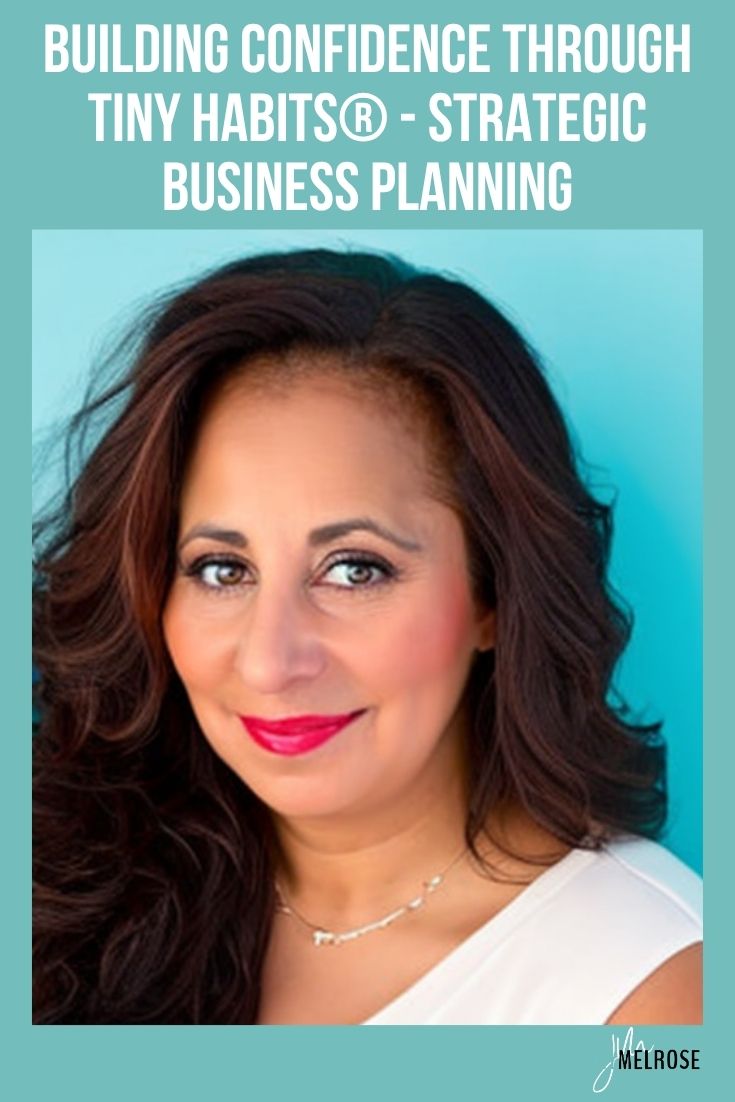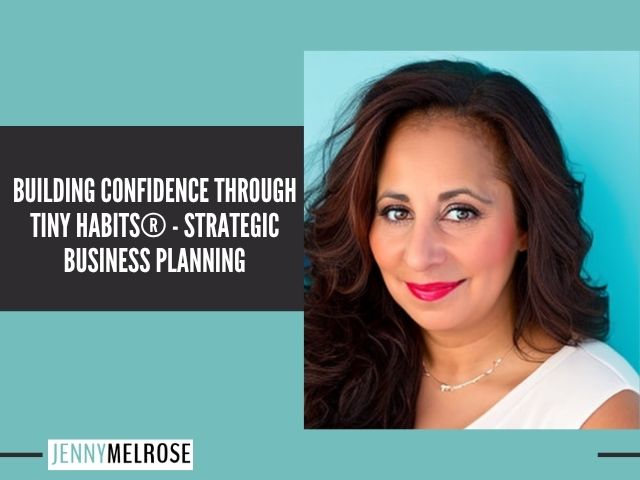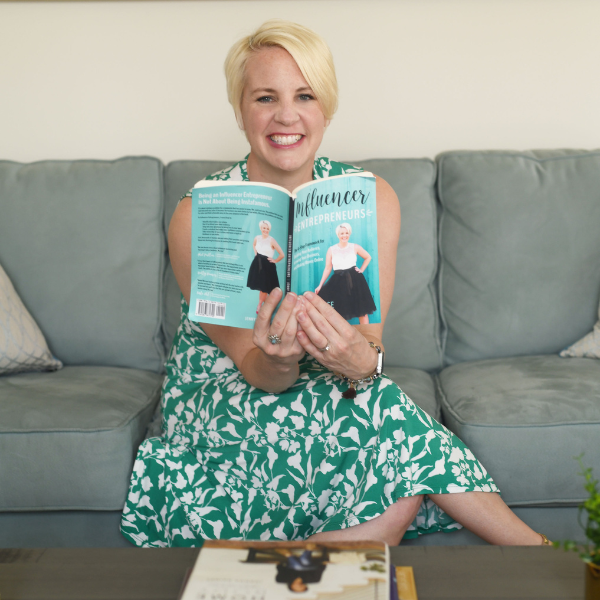Discover how small, consistent actions can transform your business confidence and results. Learn how to use Tiny Habits® to create a strategic plan that aligns with your goals and builds unstoppable momentum.
IE 469: Building Confidence Through Tiny Habits® – Strategic Business Planning with Julie DeLucca-Collins

Julie’s journey to becoming a Tiny Habits® coach began with a personal realization. Even with years of corporate success, including a role as chief innovation officer at a national educational company, she still struggled to maintain habits that mattered to her.
She discovered that motivation alone was not enough. It was the action, no matter how small, that created momentum and lasting change.
After hearing Dr. BJ Fogg, the founder of the Behavior Lab at Stanford University and author of Tiny Habits, speak, Julie recognized the missing piece in her own approach.
She became certified as a Tiny Habits coach, learning to start small, pair new behaviors with existing routines, and celebrate even the tiniest successes. This approach not only transformed her own life but also inspired her to help others create consistent, lasting habits.
Can you give an example of stacking tiny habits?
When it comes to creating lasting change, Julie explains that one of the key principles of the Tiny Habits® method is habit stacking; pairing a new behavior with an existing one.
She shares one of her own favorite examples. “For me to stay consistent, alert, and in a good spirit, I have to drink water,” she says. “Every night before bed, I leave my water bottle by the kitchen sink. Each morning, I let my dogs out—something I do every day.
As soon as I open the door for them, I see the water bottle, fill it up, and tell myself, ‘Good job, Julie, you’re a girl who drinks water every day.’ That simple act reinforces the habit and sets a positive tone for my morning.”
Jenny adds her own example. “I’ve started leaving the book I’m reading for professional development on my desk. Before, I kept it by my bed but often got distracted by my phone. Now, when I sit at my desk to start the day, I grab the book and read a chapter. It’s become a natural part of my morning routine.”
Julie agrees that setting yourself up for success is all about making it easy for your furture self. “Leave the book where you can see it. Put your water bottle in the right place. The goal is to make it effortless to follow through,” she says.
She explains that this principle applies not just to personal habits but to business as well.
“Entrepreneurs tend to be full of great ideas, but sometimes we’re not strategic. We lose momentum when things don’t go as planned or when something new distracts us. I teach my clients to plan their weeks with clear, actionable steps that move them toward their goals.”
Julie practices what she teaches. “When I sit at my desk each morning, the first thing I do is look at my planner. I’ve already mapped out my month, so I check the specific actions for the day.
For example, today’s Friday, and I’m recording a podcast with Jenny. My goal for the year is to be on 26 podcasts, so this action keeps me moving toward that goal. Staying grounded in the plan helps me maintain momentum and intentionality.”
Jenny summarizes it perfectly: “It’s about consistency; doing it every single day, staying focused, and making sure your daily actions are connected to your long-term goals.”
How do you help business owners use the Tiny Habits® framework when creating a strategic plan?
When working with business owners, Julie begins with a time assessment to understand how they are spending their days. “We often let days happen to us instead of approaching them with intentionality,” she explains.
“We may have big dreams, but we need to categorize them. Is this something we can do in the next 90 days, six months, a year, or even three years?”
Once the vision is clear, Julie helps entrepreneurs design their plans by working backward. Her background as a teacher shows up in this “backward design” approach.
“If this is where we want to go, what steps do we need to take to get there?” she says. Sometimes it starts with something as simple as using sticky notes to outline every action needed to reach a goal.
“For example, if your goal is to be a guest on podcasts, write each action on a sticky note.
One might say ‘research podcasts,’ another ‘listen to potential shows,’ another ‘send outreach emails,’ and another ‘follow up.’ Once you see all the steps, you can decide when each one should happen. Is it a daily task or a weekly one? Then, schedule it into your calendar.”
Julie emphasizes the importance of metrics in keeping momentum and accountability. “We cannot skip tracking,” she says. “If we do not measure what is happening, we lose the ability to recalibrate.”
Each week, she reviews progress with her clients by asking questions like, “What actions did you take? What did you skip? What small adjustments can we make to keep things moving?”
When Jenny asks if those metrics refer to tracking actions rather than outcomes, Julie clarifies. “Exactly. There are two kinds of numbers: lagging metrics, which are results like how much revenue you brought in, and leading metrics, which are the actions you can control. You cannot control how many people download your podcast, but you can control whether you publish an episode, post about it, and create backlinks. Those are the actions that move the needle.”
Julie breaks her goals into 12-week segments rather than waiting for a new quarter to begin. “Life happens, and if things go off track, our brains tend to say, ‘I’ll start again on Monday.’
Instead, with a 12-week cycle, you can recalibrate immediately. You can start fresh today and keep your momentum.”
Jenny points out that this shift in focus helps business owners stay consistent. “When people focus only on the results, they get discouraged and lose motivation. But when they track consistent action, progress follows naturally.”
Julie agrees. “So many people fear numbers because they think numbers define their worth. But numbers are neutral. They are information that helps us make decisions. The most successful companies look at the data, make adjustments, and keep going. Entrepreneurs need to do the same—step into the role of a confident CEO who uses data to guide strategy, not emotion.”
What are some of the most common mistakes people make when trying to build new habits in their business?
When it comes to building new habits, most people try to do too much, too fast.
Julie explains it perfectly: “We tend to look at someone who’s already running a marathon and think, ‘I can do that.’ But if you haven’t been running in years, you can’t just start running every day. Go to the mailbox. Walk around the block. Then celebrate that small win and say, ‘Good job. I did it.’”
One of the biggest mistakes is failing to plan when the habit will happen. “We might say we’ll walk around the block every day, but if we don’t decide when it will happen, it usually won’t,” Julie shares.
Setting the stage for success is key. “If I didn’t plan when I’m going to the gym, or I don’t know where my shoes and workout clothes are, I’m already setting myself up for failure. I used to think people were crazy when they said they put their workout clothes out the night before, but it really helps. When you wake up and see them, it’s a visual cue that today is a gym day.”
Julie emphasizes that consistent action creates traction. Many people think habit-building is about a specific number of days, like twenty-one or sixty-six.
“But it’s not about counting days,” she says. “It’s about small, consistent action. Think of each tiny habit as planting a seed. You water it, give it sunlight, and care for it, but you don’t control how fast it grows. Your job is simply to nurture it.”
In both business and life, Julie says the real key is to focus on what you can control and set up your environment for success. “When we take control of our environment, pair new habits with existing ones, and celebrate even small progress, that’s when true change begins to take root.”
Passion to Profit
Julie created Passion to Profit as the tool she wishes she had when she was in her corporate career. “I loved my career and I did well, but there was always this little voice in my brain and heart saying, wouldn’t it be nice to have a roadmap for turning my passion into a business?” she explains.
Having a passion or talent is just the starting point. Julie emphasizes the importance of knowing whether people care about your passion enough to pay for it.
“We need to set the stage so that when we leave a nine to five, we can do so strategically. It’s about creating a plan that positions you to be a consistent and confident CEO, not just someone who is excited about what they do.”
She also highlights practical considerations that many new entrepreneurs overlook, like pricing and understanding the value of your services. “I knew my corporate experience had value because I had charged school districts for my work, but I didn’t know how that translated to coaching.
Passion to Profit gives a framework to handle these nuances and set yourself up for success.”
The program is designed to help entrepreneurs clarify their passions, understand their market, and create a strategic plan that turns their skills and enthusiasm into a profitable business.
Action Steps:
- If you liked this episode of Influencer Entrepreneurs, please subscribe and leave a fabulous review!
- Join the conversation on Instagram by tagging Jenny when you’re listening to the podcast. She’ll send you a personal message whenever you tag her.


